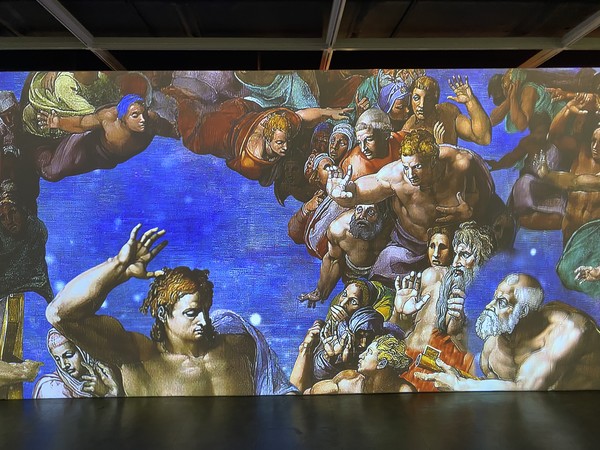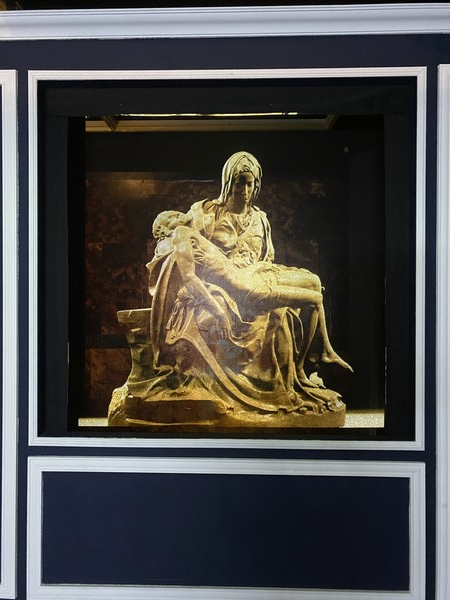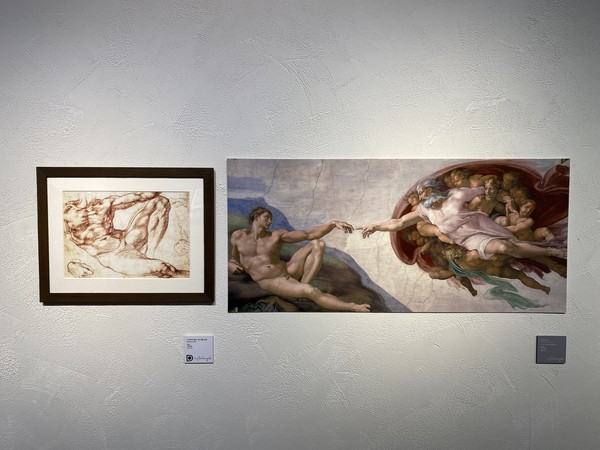Combining 16th century masterpieces with 21st century technology

THE SISTINE Chapel ceiling, The Last Judgement, Pietà, David—these are just a few of Michelangelo’s highly acclaimed Renaissance masterpieces. Most of his artworks are frescoes [1] in the Sistine Chapel and marble sculptures that are part of the architecture, making them impossible to transport for display. In order to appreciate Michelangelo’s artworks in person, tourists would have to travel all the way to Italy. Unfortunately, viewing his art has become even more challenging now with travel restrictions. However, for all the art enthusiasts out there, there is another option. The M Contemporary Art Center of Le Méridien Hotel has opened “God’s Artist-Michelangelo Special Exhibit,” bringing to us a unique artistic experience that combines modern technology with Michelangelo’s art.
Introducing “God’s Artist”
Michelangelo di Lodovico Buonarroti Simoni was an Italian artist of the Renaissance era. Also known as il divino, he was celebrated for his divine skills as a painter, sculptor, engineer, and architect. Thanks to him, painters and sculptors were no longer referred to as “mere decorators” or “stonemasons,” but rather, creators [2]. With his renowned use of space, light, and shadow, and the complexity and tension within his artwork, Michelangelo continues to inspire many artists today and is still considered the true genius of Renaissance art [3].
“God’s Artist-Michelangelo Special Exhibit” takes us through Michelangelo’s artistic journey, introducing him as a sculptor, painter, architect, and poet. The exhibition presents both digitally restored and animated versions of his work—along with quotes from his poems. As you walk through the exhibition hall immersing yourself in his artistic journey, you will feel as if you have become a part of Michelangelo’s artistic visions themselves.

The angel in the marble
The first work you will come across is Moses, one of Michelangelo’s celebrated sculptures of the famous biblical character as a digital hologram. Michelangelo’s identity as a sculptor is expressed through his words, “I saw the angel in the marble and carved until I set him free,” written on the wall. Along with the sculptures, the exhibit teaches us about the different types of Carrara marble [4]—Bianco Carrara, Statuario, Calacatta, and Arabescato—and sculpting tools Michelangelo preferred using. An accompanying video allows the viewers to visualize and further comprehend the process of creating a sculpture from start to finish.
Another one of Michelangelo’s phrases—"Carving is easy. You just go down to the skin and stop”—welcomes the viewers as they enter the adjacent hall, where his artistic studies of the human anatomy are displayed. In seeing the numerous digitally restored sketches that so intricately express the wrinkles, bends, and curves of the human body, the viewers would realize Michelangelo applied such anatomical knowledge onto his life-like sculptures. The physical details of the sculptures are captured especially well with digital technology. The Pietà, like Moses, is presented as a digital hologram; unique holographic imaging techniques allow the sculpture to appear 3-dimensional on a 2-dimensional screen. The Medici tomb and David, on the other hand, utilize animation as their medium; this technology rotates and zooms in to show us the sculptures from a variety of angles, letting us have a closer look at the otherwise-unnoticeable details. Dying Slave incorporates an additional interactive system in its presentation; viewers can see the slave’s limp, expiring muscles, adding to the deep emotional quality of the piece that further resonates with them.

The divine frescoes
In addition to Michelangelo’s sculptures, the exhibition also displays his renowned frescoes using a variety of digital technology. The exhibit thoroughly provides both the detailed images of the frescoes and the creation process of the artworks, including various studies and sketches of Michelangelo’s paintings that served as the basis of his world-renowned masterpieces.
This portion of the exhibit focuses on Michelangelo’s frescoes that adorn the ceilings and walls of the Sistine Chapel. Digital renditions of the paintings allow the visitors to see these frescoes right in front of their eyes without having to squint to view the paintings hanging 20 m over their heads. In particular, the exhibit displays the portions of the Sistine ceiling that depict the Story of Creation, the Story of Noah, and the prophets who foretold the Messiah’s arrival. The viewers can vividly observe the characters’ different facial expressions and body language that would otherwise remain unnoticed if it were not for such digital techniques. The details together help us better comprehend the many stories that fill up the Sistine ceiling. Not only this, but the preliminary sketches displayed next to digitally rendered artworks also let the viewers fully appreciate the different stages of Michelangelo’s elaborate creations.
The following zone further incorporates animation technology in delivering some of Michelangelo’s most prominent frescoes, such as The Last Judgement and The Crucifixion of St. Peter. The animation gives life to the characters from the paintings, allowing them to move around, thus offering a more vivid and almost movie-like depiction of the stories Michelangelo wanted to convey through his work. The exhibit adds an extra touch of creativity in attempting to recreate the actual environment of the Sistine Chapel, which is achieved by projecting the ceiling’s frescoes on the ceiling and The Last Judgement on the wall of the halls.
Although these artworks are presented with technology as their medium, the exhibit aims to accurately replicate the complicated beauty of the original works and enrich its viewers with knowledge of Michelangelo’s art.
When art meets modern technology
With its new take on combining Michelangelo’s artworks with technology, “God’s Artist- Michelangelo Special Exhibit,” has attracted many art enthusiasts, ranking first in the Interpark tickets category even before its opening. The technology utilized in this exhibit strives to enrich the artistic delivery of Michelangelo’s pieces by including digitally enhanced, interactive displays. Additionally, the “God’s Artist” exhibit provides detailed curations of the artworks and the processes behind each of their creations, providing an adequate balance between artistic and informative elements. In making the pieces more accessible and easier to intellectually digest, this exhibition closes the geographical and artistic gap that had previously existed between Michelangelo’s masterpieces and its modern audiences in South Korea.
With the development of cutting-edge technology, it is essential to recognize its role and significance in the modern art scene. If incorporated insightfully, it has the potential to synergize with artworks and give enhanced results. “Visiting the Sistine Chapel was surely an awe-inspiring experience but being able to appreciate ‘even’ the finest details of Michelangelo’s artworks with the help of technology is a new experience entirely,” says Kim Dasom, a visitor of the exhibit, in an interview with The Yonsei Annals. The integration of 21st century technology and 16th century masterpieces demonstrated in the “God’s Artist” exhibition expanded the realm of artistic expression and delivery, leaving the audience wondering where it will be heading next.
Period: 2020.12.04-2021.05.02 (closes on the last Mondays of every month)
Hours: 10:00 a.m.-19:00 p.m. (last entry: 18:00 p.m.)
Admission: \15,000 (ages 19 and older), \13,000 (ages 13-18), \10,000 (ages 3-12)
Address: M Contemporary (1F, Le Meridien Hotel, Bongeunsa-ro 120, Gangnam-gu, Seoul)
[1] Fresco: a style of painting done on wet plaster on top of a wall or ceiling; the colors penetrate the plaster and are fixed as it dries.
[2] Visual Arts Encyclopedia
[3] Britannica
[4] Carrara marble: types of marble found in Carrara, Italy

